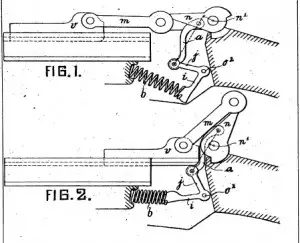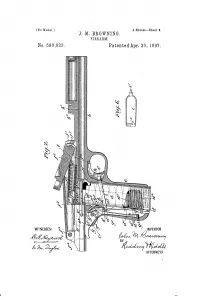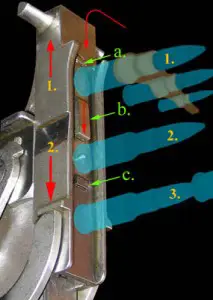In the early days of semi- and automatic weapons, one very common locking mechanism was a toggle lock. This lock works like a human knee joint: it would bend freely once bent, but when “straight” it was over-center and pressure on the “bolt face” (or sole of the foot) just locked it more firmly. This somewhat kitschy video does show the classic form of toggle-locking, the Pistole 08 Parabellum, known to generations as the Luger after its designer.
A knee bends on the volition of its owner; a gun toggle-joint when recoil cams the “knee” up or down, away from its over-center, locked position. All successful toggle-locked systems have been recoil-operated, although as far back as 1895 John Browning proposed a gas-operated variant, complete with a pistol design and a gas tap much like that of the Colt “potato digger” machine gun, connected directly to a locking toggle. He received a patent on this dead-end design in 1897.
Military arms enthusiasts usually ascribe this design to Maxim, who used a long-recoil variant; and note that Borchardt and Luger made it compact and portable (theirs is a short-recoil variant). And it is true that Maxim’s machine guns used the toggle before any other automatic weapon.
Maxim’s fiendishly complex lockwork (later simplified by many improvers, including Maxim himself) had to withdraw a (rimmed) cartridge from cloth or metal belt, position the cartridge, ram it into the chamber, lock, fire the cartridge, unlock, extract the spent cartridge, and eject it. And it had to do all this off the recoil impulse of a rifle-caliber cartridge. That’s a lot of things to do and it’s not surprising that the first designers to do it didn’t achieve optimum simplicity.
The toggle lock wasn’t simple, but it was two things more important in a fledgling MG design: safe and reliable. But Maxim wasn’t the first to use the toggle lock by any means.
The toggle lock was a standard mechanism known to all mechanical engineering graduates in the mid to late 19th Century. It found its way into small machinery like machine tools and large machineries like steam engines and movable bridges. It was used in a number of iconic guns of the period, including the Henry rifle and the Winchester ’66 and ’73. (The Henry/Winchester version was prone to toggle pin deformation from fatigue or overload; in the Winchester 1886 a new version, the Winchester 1886, basically solved this problem for itself and Winchesters going forward. The ’86 was designed by John M. Browning).

Winchester ’73 (this is the current version, made by Miroku in Japan for Winchester). Click to embiggen a little. Didn’t know it was a Luger’s cousin, did ya?
Indeed, the earlier Henry/Winchester toggle lock came over more or less intact from the then-radical Volcanic lever-action repeating pistol and rifle, which used a unique cartridgeless projectile that carried its powder inside the bullet skirt. The rimfire of the Henry and centerfire cartridges of the Winchester were considerably more advanced and practical than the Volcanic’s self-contained rounds, but the mechanism was adequate until it became necessary to make lever guns in stronger calibers and for smokeless powder, both of which brought higher chamber pressures.

George Luger’s rifle toggle-lock patent. The mechanical setup and mechanical advantage of the recoil spring are changed but it’s otherwise very close to the pistol.
Toggle locks spread from lever-action to the above-mentioned Borchardt and Luger pistols. Luger also designed a rifle based on a toggle lock very similar to the P.08 and other Luger pistols’, but it was never accepted. The almost-last hurrah of the toggle lock, if we discount Maxims and Vickers guns which served well into the last quarter of the 20th Century, was the Pedersen rifle made for US Army trials in the experimental .276 Pedersen caliber. Guns.com has a little bit on the Luger and Pedersen rifles, and they’re riffing off this post over at Forgotten Weapons, which includes a link to a Luger patent for the rifle. FW also has plenty on the Pedersen and even a feature on a Japanese copy of the Pedersen.
Almost last? Yes. The toggle lock came back with the Kriss submachine gun/SBR in the last few years. Workable technology never dies, it just falls out of fashion until somebody figures out a new way to exploit it.
Remember, for about 80 years they thought the Gatling gun was dead. But that’s another story.

Kevin was a former Special Forces weapons man (MOS 18B, before the 18 series, 11B with Skill Qualification Indicator of S). His focus was on weapons: their history, effects and employment. He started WeaponsMan.com in 2011 and operated it until he passed away in 2017. His work is being preserved here at the request of his family.



5 thoughts on “A short history of toggle locking”
The gas-operated Browning pistol shown in the patent was built, but only as a prototype,
Just remembered that the Browning prototype is on the cover of the June 1975 issue of “American Rifleman.”
Well, there were other toggle lock guns, such as Swiss Lmg.25 by Rudolf Furrer (see http://world.guns.ru/machine/switch/wf-lmg-25-e.html ) and Lmg.Pist 41/44 from same designer ( http://world.guns.ru/smg/switch/w-f-lmg-pist-41-44-e.html )
Both were excellent examples of fine Swiss over-engineering
Another almost forgotten example is the line of semi-automatic rifles and carbines designed by Karl Heinemann of Rheinmetall-Borsig in late 1920s and early 1930s. One of his rifles in 7mm Pedersen was tested by US army. It had toggle-lock that opened to the side rather than to the top
And, finally, some modern biathlon small-bore rifles still use manually operated toggle lock action (also with horizontal toggle, see http://www.izhmash.ru/eng/product/bi-7.shtml )
Spasibo, Max
I always learn something from a post!
I had let Furrer slip my mind but didn’t know about the Heinemann gun or the guns for biathletes. Last time I saw Russian biathletes compete, they were using bolt action rifles, but that was long ago.
I realized after putting the post up that I missed the chance to explain what was good about a toggle lock: very positive locking, easy action, and high strength to weight ratio.